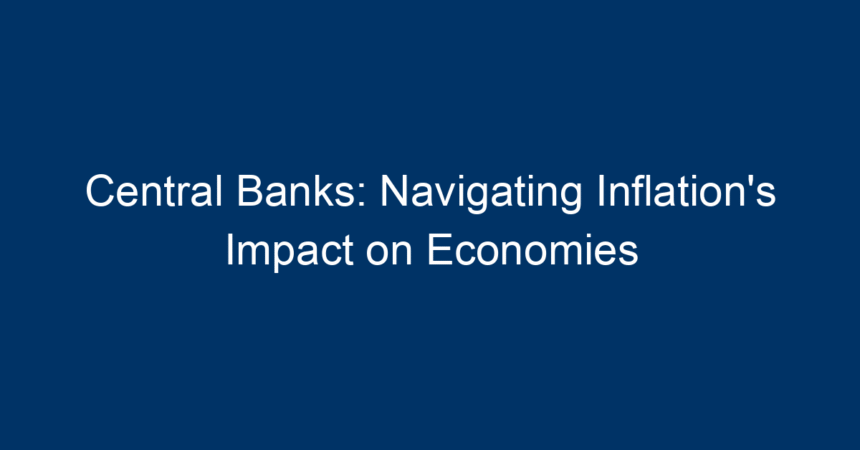In recent years, the global economy has faced an unprecedented challenge: inflation. While inflation is a normal part of any economic cycle, the recent surge in prices has posed significant challenges for policymakers worldwide. Central banks, as the guardians of monetary stability, have taken center stage in this struggle. This article explores the pivotal role of central banks in navigating the complex landscape of inflation and its profound impact on economies.
Understanding Inflation and Its Causes
What is Inflation?
Inflation refers to the rate at which the general price level of goods and services rises, eroding purchasing power. As prices increase, each unit of currency buys fewer goods and services, affecting both consumers and businesses. Central banks focus on maintaining price stability, often targeting an inflation rate of around 2% per year.
Causes of Inflation
Multiple factors contribute to inflation, and it’s crucial for central banks to understand these causes to tailor effective strategies:
-
Demand-Pull Inflation: Occurs when demand for goods and services exceeds supply. This often results from increased consumer spending, government expenditure, or investment.
-
Cost-Push Inflation: Arises when production costs rise, leading producers to increase prices. Factors influencing this include higher wages, increased raw material costs, and supply chain disruptions.
- Built-In Inflation: Results from adaptive expectations. For instance, if workers anticipate rising prices, they may demand higher wages, which can lead to a wage-price spiral.
The Role of Central Banks in Controlling Inflation
Monetary Policy Tools
Central banks employ various tools to manage inflation and stabilize the economy:
-
Interest Rate Adjustments: By raising or lowering interest rates, central banks influence borrowing and spending. Higher interest rates make loans costlier, reducing consumer spending and business investments, thereby cooling inflation.
-
Open Market Operations: Central banks buy or sell government securities to influence the money supply. Purchasing securities injects money into the economy, while selling them diminishes the money supply.
- Reserve Requirements: Banks are required to hold a certain percentage of assets in reserve. By adjusting these reserves, central banks can directly influence the amount of money available for lending.
The Dual Mandate
Many central banks, like the Federal Reserve, operate under a dual mandate: promoting maximum employment and ensuring stable prices. Balancing these objectives can be challenging, especially during periods of high inflation. The central bank must navigate the trade-offs between stimulating economic growth and curbing inflation.
Recent Trends in Inflation and Central Bank Responses
Post-Pandemic Inflation Surge
The COVID-19 pandemic triggered significant economic disruptions, leading to supply chain constraints and unprecedented government spending. As economies reopened, demand surged, driving inflation rates to multi-decade highs. Central banks had to quickly adapt their strategies to counteract this inflation wave.
Central Banks’ Responses
-
Tapering Asset Purchases: Many central banks have decreased their asset purchasing programs. Tapering helps reduce liquidity in the market, a crucial step in combating inflation.
-
Interest Rate Hikes: In response to rising inflation, central banks worldwide started increasing interest rates. This move aims to temper consumer spending and gradually bring inflation under control.
- Forward Guidance: Central banks are increasingly using forward guidance—communicating their future policy intentions—to influence market expectations and stabilize economic activity.
The Challenges Central Banks Face
Data Dependence
Central banks rely heavily on economic data, such as CPI (Consumer Price Index) and unemployment rates, to inform their decisions. However, the lag in data collection and the dynamic economic environment can complicate timely responses to inflationary pressures.
Global Economic Interconnectivity
Inflation is not isolated to one economy; it is a global phenomenon. Central banks must consider international factors, such as inflation in trading partners or geopolitical tensions, which can impact domestic inflation rates.
Public Perception and Credibility
The effectiveness of central banks hinges on their credibility. If the public perceives that a central bank is incapable of controlling inflation, it may lead to increased inflation expectations, creating a self-fulfilling prophecy. Maintaining trust and transparent communication is critical.
Conclusion: Actionable Insights for Navigating Inflation
The role of central banks in navigating the complexities of inflation is more crucial than ever. Here are some actionable insights for various stakeholders:
-
For Policymakers: Emphasize the importance of timely and data-driven monetary policy. Collaborate with fiscal authorities to create synergistic strategies for economic stability.
-
For Businesses: Be proactive in managing costs and pricing strategies. Monitor inflation trends and anticipate potential shifts in consumer behavior to stay competitive.
-
For Consumers: Stay informed about inflation and its implications for purchasing power. Prioritize budgeting and consider diversified investment strategies to safeguard against inflation.
- For Investors: Understand the monetary policies of central banks and their potential effects on financial markets. Interest rate hikes can impact sectors differently; adjust portfolios accordingly.
In navigating inflation’s challenges, central banks play a vital role, balancing their mandates to foster economic stability. Understanding their strategies not only aids policymakers but also offers insights for businesses, consumers, and investors in making informed decisions in an inflationary environment. By remaining adaptable and well-informed, stakeholders can effectively weather the storm of inflation and emerge stronger in the post-pandemic world.




